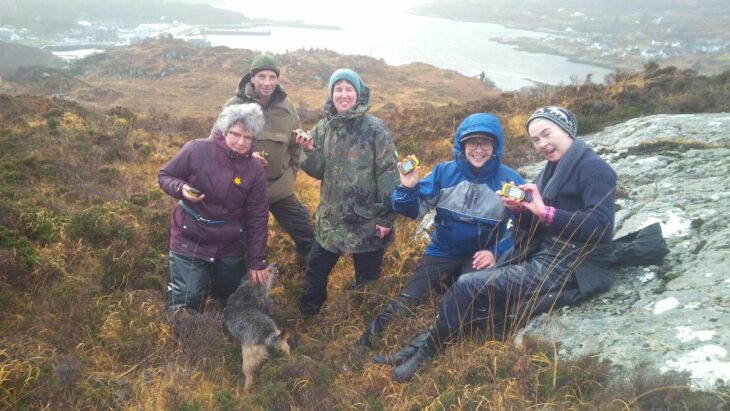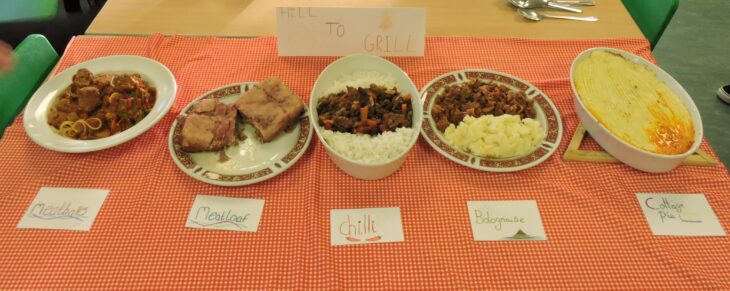MSP opens new community deer larder
Local MSP Maree Todd opens the new deer larder. c. Chris Puddephatt MSP for Caithness, Sutherland and Ross, Maree Todd, officially opened the new…
Deer management in Scotland is overseen by NatureScot, with decisions and actions at a local level undertaken by Deer Management Groups (DMGs) who co-ordinate activity between the landowners and managers within each area. The CALL area falls within the West Sutherland Deer Management Group (WSDMG) which itself is split into four sub-groups, two of which fall within the CALLP Scheme area.
Deer range is one of the primary land uses in Coigach and Assynt, and deer management can have both positive and negative impacts – on the local economy (by generating income), the community (by employing stalkers and support workers), and the environment (by the impact of deer on habitats).
The aims of the project were to:
Under these three areas the project achieved the following:
Training
18 people were trained, achieving the recognised qualification DSC Level 1 (Deer Stalking Certificate). The location of the courses has previously been a barrier to those wanting to undertake the training, so being able to arrange for the trainer to come to Assynt meant that several involved in local deer management were able to gain this qualification which is generally accepted as a minimum standard within the sector today.
Three people completed the Sustainable Deer Management module with University of Highlands and Islands. This is a standalone Continuing Professional Development (CPD) online module from the postgraduate MSc degree course in Sustainable Mountain Development.
Five people attended a venison butchery workshop. This was an informal training day with a highly experienced local stalker. Participants were taught how to make the best use of and prepare cuts from a venison carcass for home use.
Four people attended a Lantra ATV (All Terrain Vehicle) training day run on Glen Canisp estate.
Data collection
In order to plan the deer management process it is critical to understand the impacts of deer grazing. All landowners have a responsibility to determine the level of impact on their ground and to do this they need to collect and analyse data collected from dwarf shrub heath and blanket bog habitats. To facilitate this major part of the Deer Management Planning process, CALLP offered habitat monitoring training to enable monitoring sites to be set up and managed to help with the ongoing data collection.

GPS training day 1 © Fiona Saywell/Scottish Wildlife Trust
Seventeen people attended this initial habitat monitoring training. All estates received a habitat monitoring kit as part of the training programme.
This data collection is part of deer management planning and an important part in helping to determine the appropriate deer population levels for the area. The data collected by each estate is used as a tool to help plan deer management. All data is sent to the WSDMG and will be compiled onto a GIS database to illustrate grazing impacts across the deer management area. Training was also given to the WSDMG Secretaries on inputting data into a GIS programme.
Venison
Larder: Working with the Assynt Foundation, a local community landowning CALL partner, and the John Muir Trust the project developed the deer larder at Glen Canisp estate. A deer larder is a key piece of infrastructure in deer management. Deer carcasses are brought to the larder, prepared and stored in the chiller section prior to game dealer collection. The old larder at Glen Canisp was no longer fit for purpose so CALLP and partners installed a new larder and refurbished and repurposed of the old larder building as an open access land management information hub. The old larder building is a typical example of a Scottish rural vernacular corrugated iron building. Refurbishing the old larder helped to conserve a good example of a socially significant part of the built and cultural heritage of rural Scotland.

A selection of venison dishes from one of our Hill to Grill education sessions. © Katrina Martin/Scottish Wildlife Trust
Venison survey and recipe booklet: Wild venison is a sustainable source of good quality meat. Using a local source of food is key to reducing food miles and part of the way everyone can help to reduce our carbon footprint. A survey was produced and circulated to gauge how many people in the CALL area utilise this high quality food that is on their doorstep. As part of this, recipes from those that do use this meat were collected with the aim of turning it into a local venison recipe booklet.
You can download the Venison Survey Report to read its fascinating conclusions, which we hope will inform decisions about its local use going forward.
Local MSP Maree Todd opens the new deer larder. c. Chris Puddephatt MSP for Caithness, Sutherland and Ross, Maree Todd, officially opened the new…
A selection of venison dishes from one of our Hill to Grill education sessions. © Katrina Martin/Scottish Wildlife Trust As part of our Sustainable Deer Management…
The CALLP team at Lairg deer larder. © Scottish Wildlife Trust/Fiona Saywell As part of the CALLP Sustainable Deer Management Project, Claire Belshaw (Chair, Assynt Foundation),…
On a soggy and breezy Thursday and Friday in December we ran GPS training workshops for people involved with deer management who need to undertake habitat condition monitoring as part…
Habitat Monitoring Programme Coordinator (£2,500) We are looking to appoint a Programme Coordinator to organise and administer the Habitat Monitoring programme within the Deer Management project as part of the…